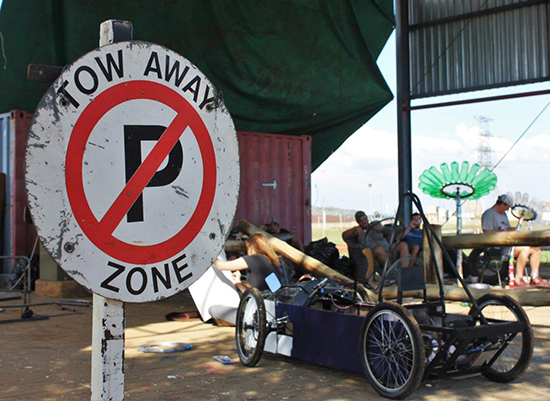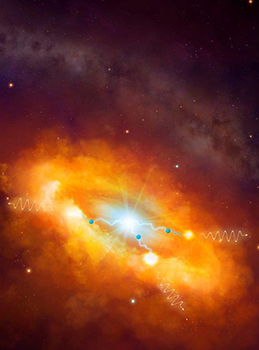Latest News Archive
Please select Category, Year, and then Month to display items
14 February 2018
Photo Moeketsi Mogotsi
 Kovsie students in the process of building their Eco vehicles
Kovsie students in the process of building their Eco vehicles
The countdown has begun to the Kovsie-ACT music festival that will take place on 17 February 2018 at the Cross Country Fields.
With just a few days left before the main event where students and the community will be wowed by performances from the likes of Prince Kaybee, Jack Parow and Shekinah, students can look forward to the "Social Cohesion" college festivities namely: the West College Project Neon party, East College Graduation party, Central College Yellow party, South College Feballoween party, North College Cowboys and Crooks party, and finally the Kovsie-ACT Fiesta Mexican party.
Each day leading up to the main event, senior on-campus residence students will be working on the building of their various Eco vehicles. Students will be grouped in their designated colleges at the UFS Rag Farm, with the support of the first-years, pending the Eco vehicle race that takes place on Friday 16 February 2018 from 13:00. The ACT office is working towards obtaining sponsors for the overall winners of the race. Their aim is to give the college that wins the race a-once-in-a-lifetime opportunity to attend an official international car race, where they will be represented by their residence committees. The following race criteria apply:
Race criteria:
| Drag race | Fastest time taken to cover distance wins |
| Slalom race | Fastest time taken to complete course minus penalties |
| Obstacle course | Fastest time taken to complete course wins (Obstacles will be introduced on the day, no preparation) |
| Three lap-race | No winner, just preparation for final endurance race but drivers must change each lap |
| Endurance race | Longest distance covered |
Students will also be working on art projects in the form of a canvas that must be made of waste materials such as plastic, scrap metal and/or sustainable organic materials. The work must be between three and five metres high and two to four metres wide. It should be durable and not perish if it is placed outdoors for a year. It must be accompanied by a manifesto that explains the theme and symbolism of the artwork so that the five colleges can effectively illustrate what is important to them and their community.
First-year students have also been assigned to participate in projects that engage with local secondary schools in the Bloemfontein area. The content of the projects will be directed through a short learning programme that will take place during the course of the year.
The Kovsie ACT team looks forward to the activities at the Rag Farm, and encourages students to attend and take part in their numbers. For more information about Kovsie ACT visit the UFS Rag page or the Ofm official website.
Two scientists part of team that discovers the source of the highest energy cosmic rays at the centre of the Milky Way
2016-03-22

Artist's impression of the giant molecular clouds surrounding the Galactic Centre, bombarded by very high energy protons accelerated in the vicinity of the central black hole and subsequently shining in gamma rays.
Artist's impression: © Dr Mark A. Garlick/ H.E.S.S. Collaboration Spotlight photo:
Dr Brian van Soelen and Prof Pieter Meintjes of the UFS Department of Physics.
Photo: Charl Devenish
|
H.E.S.S. (High Energy Stereoscopic System) scientists publically revealed their latest galactic discovery in the international science journal, Nature, on 16 March 2016. These scientists were able to pinpoint the most powerful source of cosmic radiation – which, up to now, remained a mystery.
Part of this team of scientists are Prof Pieter Meintjes and Dr Brian van Soelen, both in the University of the Free State (UFS) Department of Physics. Dr Van Soelen explains that they have discovered a proton PeVatron – a source that can accelerate protons up to energies of ~1 PeV (10^15 eV) – at the centre of the Milky Way. The supermassive black hole called Sagittarius A has been identified as the most plausible source of this unprecedented acceleration of protons.
The protons are accelerated to Very High Energy (VHE) gamma rays. The energy of these protons are 100 times larger than those achieved by the Large Hadron Collider at CERN (the European Organization for Nuclear Research).
According to Dr Van Soelen, the fact that this research has been published in Nature demonstrates the importance and pioneering nature of the research conducted by H.E.S.S. The H.E.S.S. observatory – operational in Namibia – is a collaboration between 42 scientific institutions in 12 countries.
In 2006, H.E.S.S. was awarded the Descartes Prize of the European Commission – the highest recognition for collaborative research – and in 2010 the prestigious Rossi Prize of the American Astronomical Society. The extent of the observatory’s significance places it among the ranks of the Hubble Space Telescope and the telescopes of the European Southern Observatory in Chile.
“The next generation VHE gamma-ray telescope,” Dr Van Soelen says, “will be the Cherenkov Telescope Array (CTA), which is currently in the design and development stage.” Both Dr Van Soelen and Prof Meintjes are part of this project as well.
H.E.S.S. has issued a complete statement about the paper published in Nature.